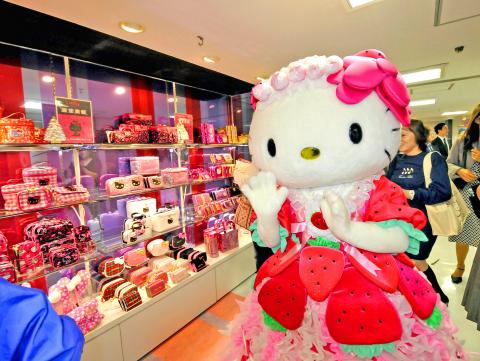Sanrio, the Japanese company behind Hello Kitty, has revealed that, despite looking like a cat, the global icon of cute is actually a female person called Kitty White.
But the news did not go down well with one furious fan known only as Liu.
It appears the youngster had her hopes and dreams dashed when she was told the news.

Photo: AFP
照片:法新社
The youngster chose to vent her frustrations in a hilarious YouTube video uploaded by her mother.
Clearly distressed and with tears in her eyes, she said, “I hate it — She looks like a cat. She cannot be a human. She is a cat that acts like a human, like in cartoons.”
The clip was posted on YouTube by user Wizardofrum, who wrote, “My daughter didn’t appreciate the truth about Hello Kitty. I didn’t know she wasn’t a cat either. Poor girl.”
However, at the very end of the video the girl realizes she may have gone too far in her criticism and warns her mum not to post the clip on Facebook.
Unfortunately for her, her mother chose to post it on YouTube instead.
(Courtesy of Liberty Times)
創造凱蒂貓的日本公司三麗鷗揭露,儘管凱蒂貓看來像貓,但這個全球可愛偶像其實是位女性,名叫凱蒂‧懷特。
但是一名姓劉的憤怒凱蒂貓迷不太能接受這個消息。
顯然這名小女孩得知此事時,她的希望和夢幻破滅了。
在一段由她媽媽上傳至YouTube的詼諧影片中,這名小女孩決定宣洩她的失望情緒。
她顯然很傷心,眼中含著淚水說:「我討厭這個消息。她看起來就是貓,她不會是人,她是像在卡通片裡那樣,是舉動像人的貓。」
這段影片被名為Wizardofrum的網友上傳到YouTube,並寫道:「我女兒不喜歡關於凱蒂貓的真相。我之前也不知道她不是貓,可憐的孩子。」
然而,在這段影片的最後,這名女孩知道也許她批評得太過火了,警告她媽媽不要將這段影片放上臉書。
對她來說很遺憾的是,她媽媽選擇上傳到YouTube。
(自由時報提供/翻譯:管淑平)

For many people in Taiwan, childhood memories of rural life include pig pens standing beside family homes. Leftover rice, vegetable scraps and soup from daily meals were poured into buckets and fed to pigs. This practice of feeding pigs with household food waste was once a common way of life, both an economic choice and an expression of agricultural society’s deep respect for conserving resources. From a practical standpoint, pigs are omnivorous animals capable of efficiently digesting food scraps that humans can no longer eat. For rural households, food waste cost almost nothing, yet it could be converted into pork, a

Sea star wasting disease (SSWD) is a strange and serious illness affecting sea stars, or starfish. This disease causes sea stars to develop painful lesions, lose their arms, and eventually turn into a gooey, melted mess. Since it was first observed in 2013, millions of sea stars along the Pacific coast of North America have died from this __1__. Although viruses were once considered a possible cause, researchers now believe that environmental stressors and microorganisms are primarily __2__ for sea star wasting disease. One of the main environmental triggers appears to be warmer ocean water. When the water heats

Tango unfolds in a dimly lit room, where a haunting melody ushers two dancers into a close embrace. Here, music and movement merge into a silent yet passionate conversation, expressing longing, memory and shared purpose. What makes tango truly magical is the deep interaction and spontaneous improvisation between partners. Tango began in the late 19th century in Buenos Aires, Argentina’s bustling capital. Born in the poor working-class neighborhoods and busy port areas, this dance emerged from a melting pot of cultures. European immigrants, African slaves and local residents all contributed to its unique character. From these rich influences, tango

Continued from yesterday(延續自昨日) https://www.taipeitimes.com/News/lang The loss of sea stars significantly impacts the ocean ecosystem. Sea stars are important __6__ that help control populations of mussels and sea urchins. Among them, the sunflower star is one of the largest and fastest sea stars and is adept at preying on sea urchins. Without sea stars, sea urchins can __7__ in numbers and devastate kelp forests. These forests are essential __8__ for many marine animals and also help capture carbon from the atmosphere, which is vital in the fight against climate change. The mystery behind SSWD is still __9__, but it is clear that